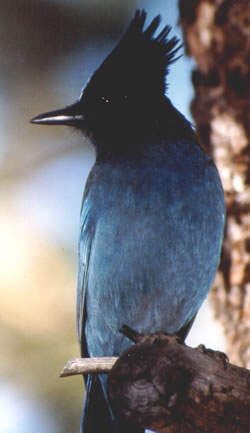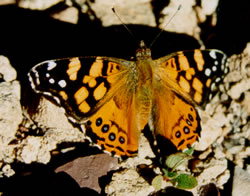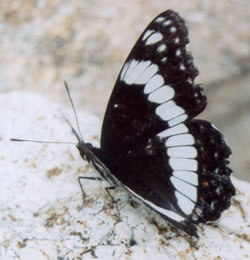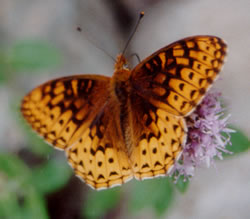The
raucous call of the jay interrupts our peace. Shook, shook,
shook is followed by some nasal notes as the bird alternates
between a series of flaps and short glides as it moves across
the forest opening. After disappearing between tall clown-white
aspens, the jay lets out one more call. This time, it is
an imitation of a red-tailed hawk’s harsh cry.
Moments later, quiet returns to the forest like the rising tide. Ah,
July in the mountains.
With the desert basting in summer heat, there is a slight coolness to
this mountain air. Here at Warner Lake a slight breeze ripples across
the water and trout rise to feed at the surface. The concentric water
circles are the only indicators of the trout’s presence. Some ducks
forage at the lake’s edge, their identities indiscernible as they
dive underwater in search of food. Ring-necks are my guess, but I don’t
have my binoculars with me today. Instead, I carry my camera attempted
to obtain close-up photographs of the “winged scales” or
lepidoptera that dance across these mountain meadows.
I spend the morning chasing sulphurs, coppers, blues, hairstreaks, skippers,
unknown moths, as well as members of the Brush-footed Family, the Nymphalidae.
Named after the appearance of their first set of legs, which are greatly
reduced and not used for walking, this family includes the admirals,
painted ladies and fritillaries. Their large size makes for easier photography
than some of these smaller butterflies.
I move slowly, stooping most of the way to minimize my presence. I also
use an extension tube with my telephoto lens, to provide some working
space between the butterfly and me. Otherwise, I have to creep and crawl
to get close enough with a close-up lens and hope that the butterfly
doesn’t spook in the process. If that happens, they metamorphose
from butterfly to flutterby.
One of the more common ones that I stalk is the Weidemeyer’s Admiral,
a striking black butterfly with a white band across its wings. This one
seems to patrol areas within the forest, often rising up to chase a competitor
from its domain. Like the jay, the flight pattern of this butterfly is
a series of flaps and glides, a characteristic that separates out the
Admirals from the rest of the fleet.
The Weidemeyer’s range is the Intermountain West, and it prefers
mountain streams and aspen glades to the lowland desert. Smart insect.
Another large member of the Brushfoots is the West Coast lady, bearing
blue dots on the hind wings and white dots set in black tips on the forewings.
Their forewings end in blunt edges, unlike the rounded tips on other
species.
These ladies cannot withstand the freezing temperatures of winter, so
migrants from Mexico colonize the area each year. Some years there are
massive migrations with the width of Utah serving as a migratory path.
Today I find only a few of these ladies intermixed with a species of
fritillary that I can not identify.
The fritillaries are also in the Brush-footed family, but identification
to the species level requires a better lepidopterist than I. Subtle differences
distinguish the species, and I take heart in reading that even the experts
may have difficulty separating out the species. These butterflies seem
to be in constant motion, moving from flower to flower.
Interrupting my pursuit of these fritillaries is a large tiger swallowtail,
one of the most striking butterflies here at 9,000 feet. I get an opportunity
to observe this yellow and black tiger-stripped butterfly as it stops
to feed. The iridescent blue along the outer wings is a striking contrast
to the pale yellow parts of the wings. Their long tails resemble those
of the barn swallow; hence, their common name – swallowtails.
It is a glorious day spent chasing butterflies and listening to montane
birds sing around the lake. The cool is a nice respite from the desert
heat, but home beckons. At home we will transform from butterfly to moth,
emerging later in the evening and attempting to avoid the heat of these
July days. |





|





